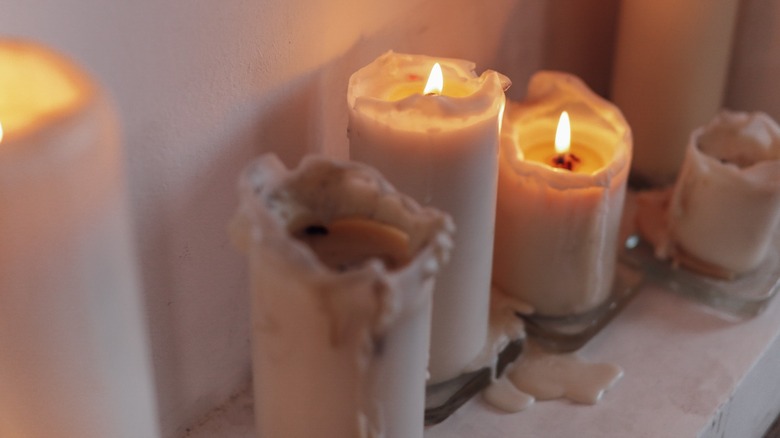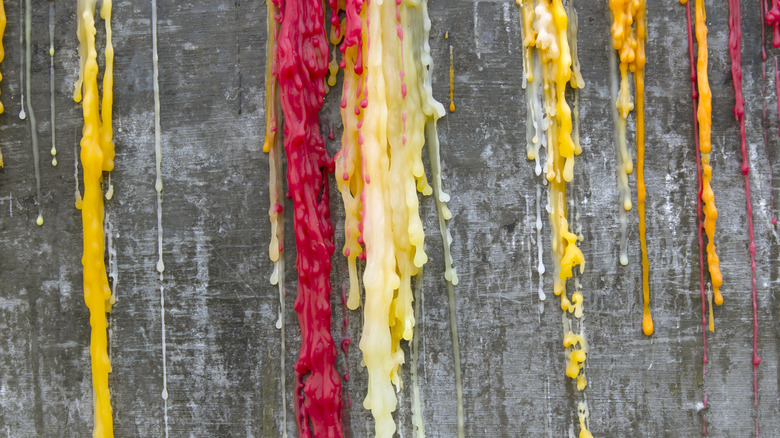How To Remove Candle Wax From The Wall Without Leaving A Mark
Your 8-year-old just blew out his birthday candles with the force of the Big Bad Wolf leaving wax splatters all over your wall. Now what? Fortunately, you don't have to run and hide like a scared little pig. Removing candle wax from walls without leaving a mark is a fairly straightforward process that requires little more than everyday household items — like vinegar — and a bit of patience.
Years ago, the only time you may have pulled out ornamental candles was to add romance to a home-cooked anniversary dinner. However, these days candles are everywhere — the mania has lit up households the world over with many unique and beautiful ways to decorate your home with candles. Whether you place the wax wonders on your nightstand, mantel, end table, or around your bathtub, candles instantly add warmth, relaxation, and coziness to any space. Unfortunately, if that space includes walls, candle wax may leave a mark if you aren't careful. Hot wax can easily splash on walls if a candle is inadvertently hit or moved before the wax has a chance to cool. Likewise, if candles are placed near vents or in drafty areas, wax splatters can mar nearby walls. To prevent the wax from leaving a permanent mark on your wall, it's critical to employ the correct cleaning method, which varies according to wall type.
Removing candle wax from painted walls
Detaching hardened candle wax from painted walls without leaving a mark can easily be achieved by resisting the urge to aggressively chip off the dried wax splatters. Instead, set a hair dryer on medium and aim it on the wax spots. The goal is to slowly heat the wax until it starts to melt. Once the wax softens, use a clean cloth to wipe it off the wall. Next, mix together 1 part vinegar to 3 parts water, dip a clean rag in the solution, and use it to wipe off any residual wax from the wall. Doing so will ensure that any marks created by the initial candle wax splatter are successfully removed. Moreover, since vinegar is a natural product, it will not negatively affect your wall's paint job.
Another option is to use a standard clothing iron and some paper towels. Start by placing the iron on the lowest heat setting. Next, cover the wax splatters with about 5 paper towels. While holding the paper towels in place with one hand, use the other to gently run the iron over the wax spots in short intervals. After a few minutes, you should see the candle wax transfer to the paper towels without leaving a mark on the wall. Once the wax has been completely absorbed by the paper towels, give the affected area a final wipe with a clean cloth or fresh paper towel.
Removing candle wax from brick and wood walls
Unlike painted walls, heat is not your friend when removing candle wax from brick. Rather, you'll need to completely freeze wax splatters with ice cubes before attempting to remove them from the brick. Also, it's vital not to rub candle wax spots prior to them freezing as doing so will cause the wax to spread out. Moreover, rubbing soft wax into brick increases the likelihood of leaving a mark as the wall will absorb the color. Frozen wax splatters can be removed by scraping with a butter knife or the side of a credit card. Any remaining sticky spots can be removed with a homemade substitute for Goo Gone: Baking soda and water.
Candle wax removal from wood walls depends on whether the wood is finished or unfinished. For the former, combine 2 parts distilled white vinegar with 1 part hot water. Next, dip a soft cloth into the mixture and gingerly wipe off any marks left by the candle wax. If you are cleaning candle wax from unfinished wood walls, which feature a rough uneven surface, start by applying baking soda to a dampened soft-bristled toothbrush. Gently brush off the wax splatters, being careful to follow the grain of the wood and making sure to get into the wall's natural ruts and creases. If residual wax marks remain, wipe the wood with a towel saturated in the aforementioned vinegar and water mixture, and allow it to air dry.


